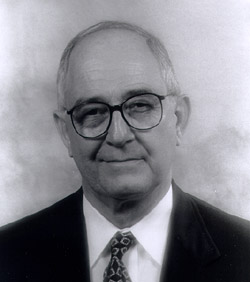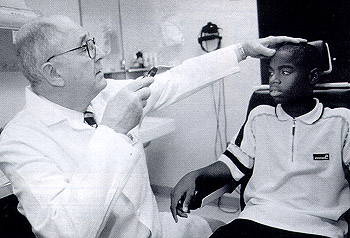Giant of Ophthalmology almost didn't make the climb

Dr. Donald Gass

Dr. Donald Gass with 12-year-old patient Kendrick Robbs. (photo by Donna Jones Bailey)
A lengthy registration line back in 1946 led Dr. J. Donald M. Gass to where he is today – one of the world's most respected ophthalmologists and experts on diseases of the retina, macula and uvea.
Gass, who grew up in Williamson County, came to Vanderbilt University in the fall of 1946 to register for his first year of undergraduate courses. He was leaning toward engineering school, even though his father was a physician who headed the Tuberculosis Control division of the Tennessee.
But when he entered the registration area, the line to register for engineering classes was much longer than the Arts and Sciences line. And the rest, so they say, is history.
"That's literally how it all got started," Gass says, laughing about his choice. "I figured I could change if things didn't work out."
Gass graduated from Vanderbilt University in 1950 and married his high school sweetheart, Margy-Ann Loser. He was obligated to spend three years in the Navy, which he spent in Korea and Japan. In 1957, he received a medical degree and the Founder's Medal from the Vanderbilt University School of Medicine. Only five members of the class of 1957 chose ophthalmology, a specialty which had attracted little attention before at VUSM. Gass credits a faculty member, Dr. George W. Bounds, with instilling enthusiasm in the five graduates.
Since then, Gass has devoted his life to studying and treating patients with diseases of one of the body's smallest organs. His career has resulted in many honors and awards of merit, including the establishment of the Gass Medal given for outstanding contributions in macular disease by the Macular Society. He was the first recipient in 1987.
This year, at age 70, he was named one the 10 most influential ophthalmologists of the 20th century. The designation came through a poll of nearly 33,000 ophthalmologists around the world, conducted by the American Society of Cataract and Refractive Surgery.
He was also the 1999 recipient of the Mildred Weisenfeld Award for Excellence in Ophthalmology from the Association for Research in Vision and Ophthalmology (ARVO).
After medical school, he served an internship at the University of Iowa, then his residency at the Wilmer Institute at Johns Hopkins Hospital and a fellowship at the Armed Forces Institute of Pathology. Then he was asked to join the faculty of the newly established Bascom Palmer Eye Institute at the University of Miami Medical School.
He and Margy had planned to come back to Vanderbilt with their children after Gass's residency, but his work at the University of Miami went well and they stayed – for 32 years.
But Vanderbilt wooed him back four years ago.
The couple planned to come back to Nashville to retire but when their daughter and her family moved to Nashville in 1995, Gass talked to Dr. Denis M. O'Day, chairman of the Department of Ophthalmology and Visual Sciences at VUMC, and decided to spend the rest of his career at Vanderbilt.
"I knew I wasn't ready to quit and Denis O'Day was kind enough to give me a job," he said.
Gass began his career practicing general ophthalmology. During this time he became actively involved in ocular surgery for cataract, glaucoma, orbital and retinal diseases and became interested in the new technique of fluoroscein angiography that for the first time permitted the detailed photographic study of physiological as well as anatomical changes in the retina and choroid.
This new technique and his skills in ocular pathology were of pivotal importance in establishing his future clinical and research interests that have involved primarily degenerative, inflammatory and neoplastic diseases of the inner eye.
One of his main efforts has been simply sorting the many inflammatory disorders that appear similar in nature, but have very different causes and outcomes. Previously, they were either unrecognized or lumped together under less specific names.
"There has been much progress in the definition of the many degenerative, inflammatory and neoplastic diseases and in determining their natural course, visual prognosis, cause and treatment," Gass said.
One of Gass's current research interests is a condition, often not recognized, that was unheard of a decade ago. The disorder, acute zonal occult outer retinopathy (AZOOR), affects mostly young women and results in a rapid loss of one of more parts of the visual field. Women suffering from this disorder often undergo extensive neurological examinations because during the early stages there is no change in the appearance of the retina.
Gass is attempting to determine the relationship between AZ00R and four other better recognized retinal syndromes that are also associated with unexplained visual field defects.
"There is a lot of interest in these syndromes and I believe that we may find a viral or other infectious agent is the cause of the visual loss."
Another of Gass's areas of research involves a disorder – diffuse unilateral subacute neuroretinitis. This disease, which is endemic in the Southeastern United States, Caribbean and Latin America, is caused by a worm that gains entrance into the blood stream, invading the area between the retina and choroid and causing severe visual loss in one eye.
In order to successfully treat the patient, the worm must be found with contact lens microscopic examination and destroyed with laser photocoagulation. Medications are ineffective and the worm is very small and difficult to locate so Gass is looking into other techniques for eradicating the worm from the eye.
The type of worm has not been identified but may be the larval form of the common dog hookworm that lives in sand or soil. Gass said patients who get the worm in their eyes usually live in or have visited a subtropical area. He saw many cases while in Miami and has seen four cases here since 1995.
Gass said the love of his career makes it hard to even think about retiring. And having two of four children and five grandchildren living in Nashville has made it easier for he and his wife to blend an honor-filled career with quality family time.
"My career has been a great deal of fun. That's why it's so hard to say I'm going to hang it up and go fishing."













